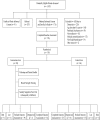Methodological challenges of multiple-component intervention: lessons learned from a randomized controlled trial of functional recovery after hip fracture
- PMID: 18751772
- PMCID: PMC2504100
- DOI: 10.1007/s11420-006-9036-x
Methodological challenges of multiple-component intervention: lessons learned from a randomized controlled trial of functional recovery after hip fracture
Abstract
We conducted a randomized controlled trial to assess the efficacy and safety of a multiple-component intervention designed to improve functional recovery after hip fracture. One hundred seventy-six patients who underwent surgery for a primary unilateral hip fracture were assigned randomly to receive usual care (control arm, n = 86) or a brief motivational videotape, supportive peer counseling, and high-intensity muscle-strength training (intervention arm, n = 90). Between-group differences on the physical functioning, role-physical, and social functioning domains of the SF-36 were assessed postoperatively at 6 months. At the end of the trial, 32 intervention and 27 control patients (34%) completed the 6-month outcome assessment. Although patient compliance with all three components of the intervention was uneven, over 90% of intervention patients were exposed to the motivational videotape. Intervention patients experienced a significant (P = 0.03) improvement in the role-physical domain (mean change, -11 +/- 33) compared to control patients (mean change, -37 +/- 41). Change in general health (P = 0.2) and mental health (P = 0.1) domain scores was also directionally consistent with the study hypothesis. Although our findings are consistent with previous reports of comprehensive rehabilitation efforts for hip fracture patients, the trial was undermined by high attrition and the possibility of self-selection bias at 6-month follow-up. We discuss the methodological challenges and lessons learned in conducting a randomized controlled trial that sought to implement and assess the impact of a complex intervention in a population that proved difficult to follow up once they had returned to the community.
Figures
References
-
- {'text': '', 'ref_index': 1, 'ids': [{'type': 'DOI', 'value': '10.1093/ageing/31.1.49', 'is_inner': False, 'url': 'https://doi.org/10.1093/ageing/31.1.49'}, {'type': 'PubMed', 'value': '11850308', 'is_inner': True, 'url': 'https://pubmed.ncbi.nlm.nih.gov/11850308/'}]}
- Hauer K, Specht N, Schuler M et al (2002) Intensive physical training in geriatric patients after severe falls and hip surgery. Age Ageing 31:49–57 - PubMed
-
- {'text': '', 'ref_index': 1, 'ids': [{'type': 'DOI', 'value': '10.1097/00002060-200003000-00008', 'is_inner': False, 'url': 'https://doi.org/10.1097/00002060-200003000-00008'}, {'type': 'PubMed', 'value': '10744190', 'is_inner': True, 'url': 'https://pubmed.ncbi.nlm.nih.gov/10744190/'}]}
- Petrella RJ, Payne M, Myers A et al (2000) Physical function and fear of falling after hip fracture rehabilitation in the elderly. Am J Phys Med Rehabil 79:154–160 - PubMed
-
- {'text': '', 'ref_index': 1, 'ids': [{'type': 'DOI', 'value': '10.1097/00004356-200209000-00011', 'is_inner': False, 'url': 'https://doi.org/10.1097/00004356-200209000-00011'}, {'type': 'PubMed', 'value': '12352179', 'is_inner': True, 'url': 'https://pubmed.ncbi.nlm.nih.gov/12352179/'}]}
- Fortinsky RH, Bohannon RW, Litt MD et al (2002) Rehabilitation therapy self-efficacy and functional recovery after hip fracture. Int J Rehabil Res 25:241–246 - PubMed
-
- {'text': '', 'ref_index': 1, 'ids': [{'type': 'PubMed', 'value': '2335719', 'is_inner': True, 'url': 'https://pubmed.ncbi.nlm.nih.gov/2335719/'}]}
- Magaziner J, Simonsick EM, Kashner TM et al (1990) Predictors of functional recovery one year following hospital discharge for hip fracture: a prospective study. J Gerontol 45:M101–M107 - PubMed
-
- {'text': '', 'ref_index': 1, 'ids': [{'type': 'DOI', 'value': '10.1016/0022-3956(75)90026-6', 'is_inner': False, 'url': 'https://doi.org/10.1016/0022-3956(75)90026-6'}, {'type': 'PubMed', 'value': '1202204', 'is_inner': True, 'url': 'https://pubmed.ncbi.nlm.nih.gov/1202204/'}]}
- Folstein MF, Folstein SE, McHugh PR (1975) “Mini-mental state.” A practical method for grading the cognitive state of patients for the clinician. J Psychiatr Res 12:189–198 - PubMed
LinkOut - more resources
Full Text Sources


